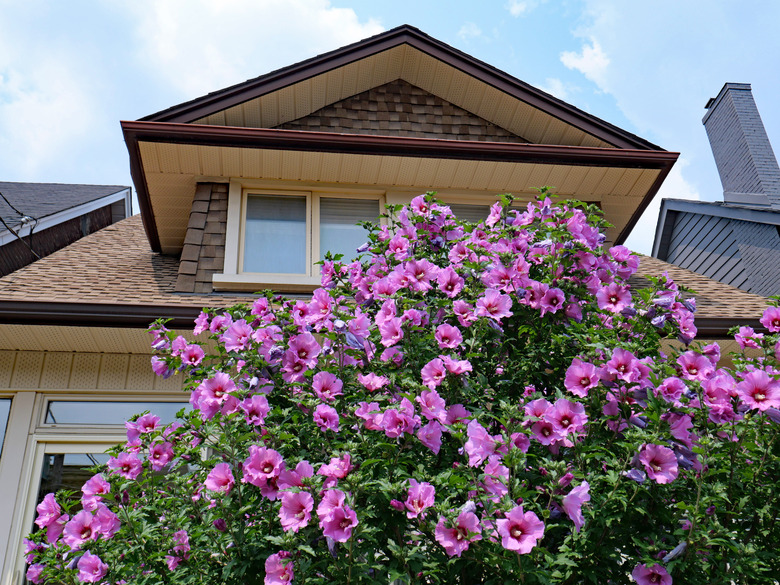The 5 Most Common Diseases On A Rose Of Sharon Tree — And How To Treat Them
We may receive a commission on purchases made from links.
The rose of Sharon (Hibiscus syriacus, USDA zones 5-9) is a large flowering shrub or small tree that typically grows 8 to 12 feet tall and 6 to 10 feet wide. Rose of Sharon plants are beloved for their large, showy flowers that bloom during late summer in a variety of colors with double or single blossoms. Unfortunately, Rose of Sharon is susceptible to several different diseases, including fungal and bacterial leaf spots, gray mold, root and crown rots, and hibiscus chlorotic ringspot virus.
Before attempting treatment, it's important to diagnose the disease your rose of Sharon tree has. Here are the five most common diseases this plant can have — and tips for disease treatment.
1. Fungal Leaf Spot
1. Fungal Leaf Spot
Diagnose fungal leaf spots by looking for small to prominent dots or raised spots on the rose of Sharon's leaves. The leaves might have yellowish or brownish spots on the surface, and the leaves may fall off.
2. Bacterial Leaf Spot
2. Bacterial Leaf Spot
Identify bacterial leaf spots or blight caused by the bacterium Pseudomonas syringae by inspecting the rose of Sharon's leaves for large, irregular or angular spots on the leaves that are brown to black in color. Plants may also have stem-tip and blossom die-back, as well as blackening leaf veins and stem cankers. Bacterial blight typically occurs during wet, rainy weather in spring.
3. Root and Crown Rots
3. Root and Crown Rots
Look for wilted foliage and discolored, stunted leaves on a rose of Sharon to diagnose root and crown rots caused by Phytophthora species fungal diseases. The leaves might drop, and a streak, stain or canker may develop on the main stems or branches. The infected bark areas might ooze a reddish-black sap as well.
4. Gray Mold
4. Gray Mold
Check for discolored or spotted flowers to identify the fungal disease gray mold, also known as Botrytis blight. Gray mold occurs during high humidity, typically causing the flower buds to rot, the leaves and shoots to wilt and drop, and the twigs to die back.
5. Hibiscus Chlorotic Ringspot Virus
5. Hibiscus Chlorotic Ringspot Virus
Diagnose hibiscus chlorotic ringspot virus by looking for stunted and distorted leaves that have streaked or spotted discoloration. The discoloration on the leaves will appear chlorotic, meaning pale-colored or yellowish. Hibiscus chlorotic ringspot virus also causes round, ringed spots on the leaves.
How to Treat Rose of Sharon Diseases
How to Treat Rose of Sharon Diseases
Though fixing your rose of Sharon's disease will largely depend on what type it's afflicted with, you can try the following disease treatments to nurse your plant back to health:
References
Remove Infected Leaves
Pick off and discard or destroy all leaves infected by bacterial and fungal leaf spot. Reduce excessive moisture on the foliage by watering early in the morning, avoiding the use of overhead sprinklers. Fungal leaf spot diseases rarely require treatments with fungicides.
Prune Infected Plant Parts
Prune away and discard all leaves, branches and stems that display symptoms of bacterial leaf spot and bacterial blight. Make the cuts with clean, sterile pruning shears or loppers. Prune the rose of Sharon when conditions are dry to prevent spreading the disease, and avoid over-fertilizing the shrub. If cankers appear on the main stems or trunk, the shrub probably will die and have to be removed.
Cut Branches Affected by Rot
Cut away all branches infected by root and crown rot. Cut back any branches that have cankers to help control the spread of the rot disease.
Discard Parts With Gray Mold
Prune away and discard all dead or dying leaves, stems, twigs, flowers and buds to treat gray mold. Clean up and discard all fallen leaves and flowers. Prune the shrub's branches to thin out the top canopy to improve air circulation, and don't use overhead watering.
Handle Regular Care
Water, prune, and fertilize your rose of Sharon properly to help improve the shrub's health and vigor if it has hibiscus chlorotic virus. No curative treatment exists for this virus, so the rose of Sharon might need to be removed if the infection begins to severely affect the shrub's growth and appearance.
